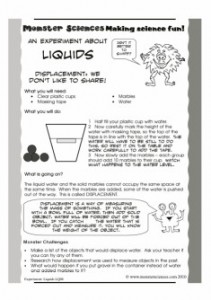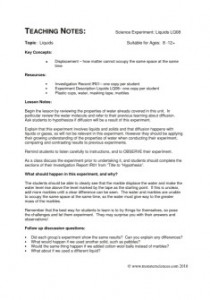What happens when there’s not enough room for everything?
 |
 |
An experiment about liquids: Displacement
What you will need:
- Clear plastic cups
- Masking tape
- Marbles
- Water
What you will do:
- Half fill your plastic cup with water.
- Now carefully mark the height of the water with masking tape, so the top of the tape is in line with the top of the water. The water will have to be still to do this, so rest it on the table and work carefully to add the tape.
- Now slowly add the marbles – each group should add 10 marbles to their cup. Watch what happens to the water level.
What is going on?
The liquid water and the solid marbles cannot occupy the same space at the same time. When the marbles are added, some of the water is pushed out of the way. This is called DISPLACEMENT.
Monster Challenges:
- Make a list of the objects that would displace water. Ask your teacher if you can try any of them.
- Research how displacement was used to measure objects in the past.
- What would happen if you put gravel in the container instead of water and added marbles to it?
Teaching Notes: Monster Sciences Experiment: Liquids LQ08
Topic:
Liquids
Key Concepts:
Displacement – how matter cannot occupy the same space at the same time
Resources:
- Investigation Record IR01– one copy per student
- Experiment Description Liquids LQ08– one copy per student
- Plastic cups, water, masking tape, marbles
Lesson Notes:
Begin the lesson by reviewing the properties of water already covered in this unit. In particular review the water molecule and refer to their previous learning about diffusion. Ask students to hypothesize if diffusion will be a result of this experiment.
Explain that this experiment involves liquids and solids and that diffusion happens with liquids or gases, so will not be relevant in this experiment. However they should be applying their growing understanding of the properties of water when conducting their experiment, comparing and contrasting results to previous experiments.
Remind students to listen carefully to instructions, and to OBSERVE their experiment.
As a class discuss the experiment prior to undertaking it, and students should complete the sections of their Investigation Report IR01 from ”Title to “Hypothesis”.
What should happen in this experiment, and why?
The students should be able to clearly see that the marble displace the water and make the water level rise above the level marked by the tape as the starting point. If this is unclear, add more marbles until a clear difference can be seen. The water and marbles are unable to occupy the same space at the same time, so the water must give way to the greater mass of the marbles.
Remember that the best way for students to learn is to try things for themselves, so pose the challenges and let them experiment. They may surprise you with their answers and observations!
Follow up discussion questions:
- Did each group’s experiment show the same results? Can you explain any differences?
- What would happen if we used another solid, such as pebbles?
- Would the same thing happen if we added cotton wool balls instead of marbles?
- What about if we used a different liquid?
Get this experiment here or as part of a bundle of Experiments about the Properties of Water here.



